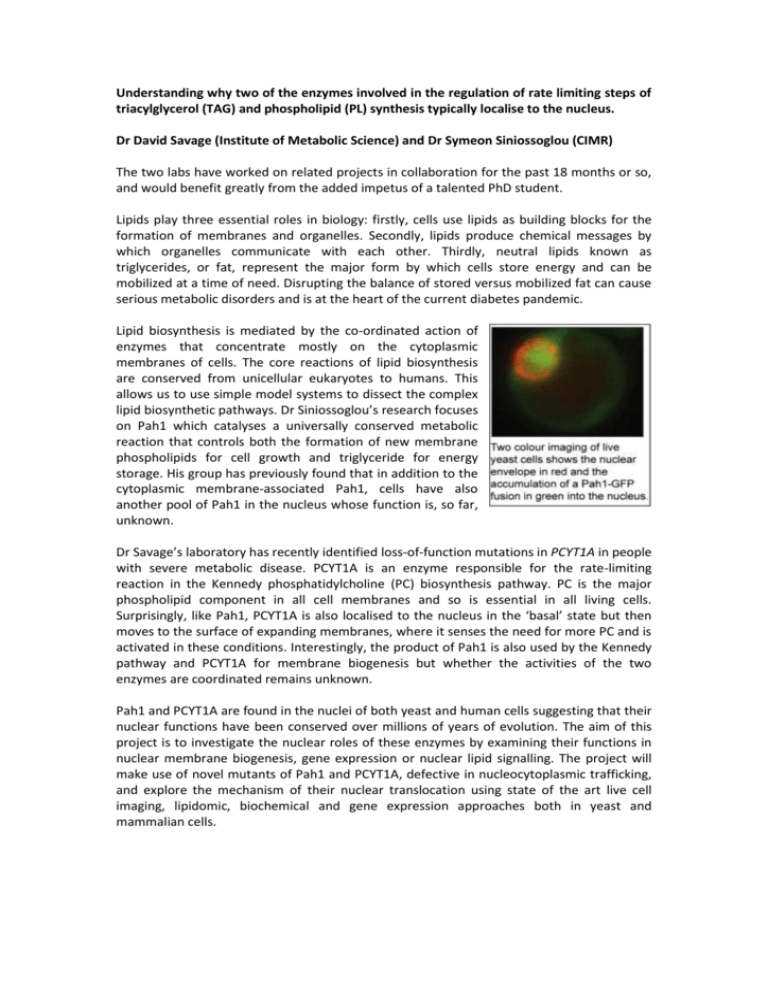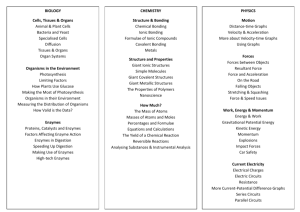Understanding why two of the enzymes involved in the regulation of
advertisement

Understanding why two of the enzymes involved in the regulation of rate limiting steps of triacylglycerol (TAG) and phospholipid (PL) synthesis typically localise to the nucleus. Dr David Savage (Institute of Metabolic Science) and Dr Symeon Siniossoglou (CIMR) The two labs have worked on related projects in collaboration for the past 18 months or so, and would benefit greatly from the added impetus of a talented PhD student. Lipids play three essential roles in biology: firstly, cells use lipids as building blocks for the formation of membranes and organelles. Secondly, lipids produce chemical messages by which organelles communicate with each other. Thirdly, neutral lipids known as triglycerides, or fat, represent the major form by which cells store energy and can be mobilized at a time of need. Disrupting the balance of stored versus mobilized fat can cause serious metabolic disorders and is at the heart of the current diabetes pandemic. Lipid biosynthesis is mediated by the co-ordinated action of enzymes that concentrate mostly on the cytoplasmic membranes of cells. The core reactions of lipid biosynthesis are conserved from unicellular eukaryotes to humans. This allows us to use simple model systems to dissect the complex lipid biosynthetic pathways. Dr Siniossoglou’s research focuses on Pah1 which catalyses a universally conserved metabolic reaction that controls both the formation of new membrane phospholipids for cell growth and triglyceride for energy storage. His group has previously found that in addition to the cytoplasmic membrane-associated Pah1, cells have also another pool of Pah1 in the nucleus whose function is, so far, unknown. Dr Savage’s laboratory has recently identified loss-of-function mutations in PCYT1A in people with severe metabolic disease. PCYT1A is an enzyme responsible for the rate-limiting reaction in the Kennedy phosphatidylcholine (PC) biosynthesis pathway. PC is the major phospholipid component in all cell membranes and so is essential in all living cells. Surprisingly, like Pah1, PCYT1A is also localised to the nucleus in the ‘basal’ state but then moves to the surface of expanding membranes, where it senses the need for more PC and is activated in these conditions. Interestingly, the product of Pah1 is also used by the Kennedy pathway and PCYT1A for membrane biogenesis but whether the activities of the two enzymes are coordinated remains unknown. Pah1 and PCYT1A are found in the nuclei of both yeast and human cells suggesting that their nuclear functions have been conserved over millions of years of evolution. The aim of this project is to investigate the nuclear roles of these enzymes by examining their functions in nuclear membrane biogenesis, gene expression or nuclear lipid signalling. The project will make use of novel mutants of Pah1 and PCYT1A, defective in nucleocytoplasmic trafficking, and explore the mechanism of their nuclear translocation using state of the art live cell imaging, lipidomic, biochemical and gene expression approaches both in yeast and mammalian cells.






